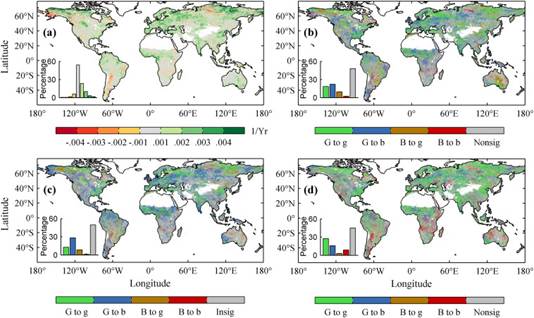研究揭示全球植被变绿长期趋势下植被生长减弱的现象
来源:《环境遥感》
时间:2018/06/19

植被生长状况是理解生态系统结构和功能的基础,在气候持续变暖的背景下,全球植被生长状况如何是全球生态学关注的热点问题,目前最广泛接受的观点是20世纪80年代初以来全球植被生长增强(变绿)。中国科学院生态环境研究中心傅伯杰团队最新研究结果揭示了1982-2013年期间,被全球植被变绿的长期趋势所掩盖的植被生长减弱现象。这一研究启示了全球变暖背景下,生态系统的变化趋势具有不确定性,其时空动态变化特征需要引起重视,研究成果发表在遥感学术期刊Remote Sensing of Environment上。
该研究利用遥感资料首次在全球尺度采用集合经验模态分解(EEMD)方法分析了1982-2013年植被生长状况的时空演化特征,并采用多种分段线性回归方法进行对比,分析发现:虽然全球植被在整个研究时段内以平均6.9*10-4 NDVI/年的速率增加(P< 0.001),但是其增速在20世纪90年代后已经放缓。三种方法均表明2010年全球植被生长增长速率降至80年代的一半以下,90年代中期以来,植被变棕的速率和分布范围都出现了增加的趋势,这一现象在北半球中低纬度地区尤为明显。1982-2013年期间,全球植被显著变棕的区域增加了两倍以上。研究给出了全球不同纬度带、土地利用类型的植被生长趋势随时间的演变过程,并发现在所有土地利用类型和北半球所有纬度带中,植被变棕的区域均有增加。研究也提供了不同方法计算的植被生长趋势发生转折的时间。
该研究受到国家重点研发计划全球变化及应对重点专项和中科院重点前沿项目的资助。(来源:中国科学院生态环境研究中心)
Increasing global vegetation browning hidden in overall vegetation greening: Insights from time-varying trends
Abstract Global vegetation dynamics are of critical importance for understanding changes in ecosystem structure and functioning and their responses to different natural and anthropogenic drivers. Under the background of rapid global warming, it is still unclear whether there were significant changes in the extent and intensity of global vegetation browning during the past three decades. Taking satellite-derived normalized difference vegetation index (NDVI) as the proxy of vegetation growth, we investigated spatiotemporal variances in global vegetation trends during the period 1982–2013 using the ensemble empirical mode decomposition (EEMD) method and two piecewise linear regression models. Our study suggests that increasing global vegetation browning is masked by overall vegetation greening. A >60% increase in browning area was found during the study period, and the results consistently indicate that the expansion of browning trends has accelerated since 1994. After the late 1990s, browning trends increased in all latitudinal bands in the Northern Hemisphere. This increase was particularly pronounced in the northern mid-low latitudes, where the greening trends stalled or even reversed. Areas with browning trends increased in all land cover types, although the increase processes varied substantially. During 1982–2013, although most vegetated lands exhibited overall greening trends, greening-to-browning reversals occurred on all continents and occupied a much larger area than browning-to-greening reversals. Greening trends prevailed before the turning points, and browning trends largely expanded and enhanced thereafter. The increased browning trends resulted in a slowdown of the increase in global mean NDVI since the early 1990s. Since drought is likely the main cause of the increasing browning trends, global vegetation growth is at risk of reversal from long-term greening to long-term browning in the warmer future.
原文链接:https://www.sciencedirect.com/science/article/pii/S0034425718302396




